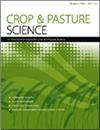4-香豆酸辅酶A连接酶基因在苗期影响大豆异黄酮的全基因组鉴定和表达谱分析
IF 1.8
4区 农林科学
Q2 AGRICULTURE, MULTIDISCIPLINARY
引用次数: 0
摘要
4-香豆酸辅酶A连接酶(4CL)基因参与植物类黄酮生物合成途径中的苯丙氨酸途径,控制类黄酮次生代谢产物的合成。异黄酮是大豆的重要品质成分(甘氨酸max)。目的研究4CL基因不同家族成员对大豆幼苗异黄酮合成的影响,并鉴定对大豆异黄酮含量有积极影响的家族成员。方法基于大豆基因组注释和bioanalytic Resource在线数据,对Gm4CL基因家族成员进行基因组鉴定和生物信息学分析。采用实时荧光定量PCR检测Gm4CL基因及异黄酮合成途径相关基因的表达情况。采用超高效液相色谱法测定各种异黄酮的含量。研究发现Gm4CL基因家族共有20个成员,分布在13条染色体上,表达主要分布在细胞质过氧化物酶体中,与花生(arachhis hypogaea)和拟南芥的4CL基因具有同源性。基因结构分析表明,Gm4CL基因有2 ~ 7个外显子。Gm4CL启动子序列含有丰富的顺式作用元件,其中Gm4CL4和Glyma.11G1945001含有MBSI顺式作用元件。苗期Gm4CL基因的表达随异黄酮的合成而变化。结论苗期Gm4CL4激活与异黄酮合成途径相关的酶,催化异黄酮合成,而Glyma.17G06440.1和Glyma.17G0645001倾向于服务于木质素合成途径,抑制异黄酮合成。这些结果表明,幼苗叶片中异黄酮的合成可能受到其他机制的调控。意义本研究为进一步研究植物异黄酮的合成和积累机制提供了基础。本文章由计算机程序翻译,如有差异,请以英文原文为准。
Genome-wide identification and expression profiling of 4-coumarate:coenzyme A ligase genes influencing soybean isoflavones at the seedling stage
Context The 4-coumarate:coenzyme A ligase (4CL) genes are involved in the phenylalanine pathway of the plant flavonoid biosynthesis pathway, controlling the synthesis of flavonoid secondary metabolites. Isoflavone is an important quality component of soybean (Glycine max).Aims The purpose of this study was to investigate the effects of different 4CL gene family members on isoflavone synthesis in soybean seedlings, and to identify those with a positive effect on soybean isoflavone content.Methods Genome identification and bioinformatics analyses of Gm4CL gene family members were conducted based on soybean genome annotation and Bio-Analytic Resource online data. Quantitative real-time PCR was used to detect the expression of Gm4CL genes, and genes related to the isoflavone synthesis pathway. Ultra-high-performance liquid chromatography was used to detect the contents of various isoflavones.Key results The study revealed 20 members of the Gm4CL gene family distributed on 13 chromosomes, with expression mainly distributed in cytoplasmic peroxisomes, and showing homology to the 4CL genes of peanut (Arachis hypogaea) and Arabidopsis. Gene structure analysis showed that Gm4CL genes had between two and seven exons. Gm4CL promoter sequences were shown to contain abundant cis-acting elements, with Gm4CL4 and Glyma.11G1945001 containing MBSI cis-acting elements. Notably, the expression of Gm4CL genes varied with the synthesis of isoflavones at seedling stage.Conclusions At seedling stage, Gm4CL4 activated enzymes related to the isoflavone synthesis pathway, catalysing isoflavone synthesis, whereas Glyma.17G06440.1 and Glyma.17G0645001 tended to serve the lignin synthesis pathway and inhibit isoflavone synthesis. These results suggest that isoflavone synthesis in seedling leaves may be regulated by other mechanisms.Implications The study provides a basis for further research into the synthesis and accumulation mechanism of isoflavones.
求助全文
通过发布文献求助,成功后即可免费获取论文全文。
去求助
来源期刊

Crop & Pasture Science
AGRICULTURE, MULTIDISCIPLINARY-
CiteScore
4.20
自引率
15.80%
发文量
111
审稿时长
3 months
期刊介绍:
Crop and Pasture Science (formerly known as Australian Journal of Agricultural Research) is an international journal publishing outcomes of strategic research in crop and pasture sciences and the sustainability of farming systems. The primary focus is broad-scale cereals, grain legumes, oilseeds and pastures. Articles are encouraged that advance understanding in plant-based agricultural systems through the use of well-defined and original aims designed to test a hypothesis, innovative and rigorous experimental design, and strong interpretation. The journal embraces experimental approaches from molecular level to whole systems, and the research must present novel findings and progress the science of agriculture.
Crop and Pasture Science is read by agricultural scientists and plant biologists, industry, administrators, policy-makers, and others with an interest in the challenges and opportunities facing world agricultural production.
Crop and Pasture Science is published with the endorsement of the Commonwealth Scientific and Industrial Research Organisation (CSIRO) and the Australian Academy of Science.
 求助内容:
求助内容: 应助结果提醒方式:
应助结果提醒方式:


